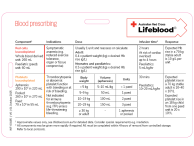Don’t have an account?
Select the donation type you’d like to make
Indications
Cryoprecipitate is used in major haemorrhage protocols to replace fibrinogen and in the treatment of fibrinogen deficiency or dysfibrinogenaemia when there is clinical bleeding, an invasive procedure, trauma or disseminated intravascular coagulation (DIC).
Refer to the National Blood Authority’s Patient Blood Management Guidelines and other evidence-based clinical guidelines for specific guidance to support clinical decisions about appropriate transfusion practices and the use of blood components.
When is cryoprecipitate not indicated?
Do not use cryoprecipitate to treat congenital afibrinogenemia or dysfibrinogenemia, haemophilia, von Willebrand’s disease or factor deficiencies where specific factor concentrates are available.
Modifications
None.
Dosage
Adult dosing
In Australia, the NBA Patient blood management guideline for adults with critical bleeding recommends an adult dose of fibrinogen of 3 - 4 g of fibrinogen, which may be achieved by using:
• 9 units of whole blood cryoprecipitate or
• 9 units of split apheresis cryoprecipitate or
• a combination of these as both unit types are equivalent and interchangeable.
This dose of 3 – 4 g of fibrinogen can also be achieved by using 3 units of large dose apheresis cryoprecipitate units while stock is still available.
Paediatric dosing
Patient blood management guidelines: Module 6 Neonatal and Paediatrics provide dosing guidance within the Critical Bleeding Protocol template for Infants and Children. The locally adapted health service Critical Bleeding Protocol and other relevant transfusion guidelines (specific to the particular patient group) should be referred to, and expert advice should be sought.
Updated September 2025




